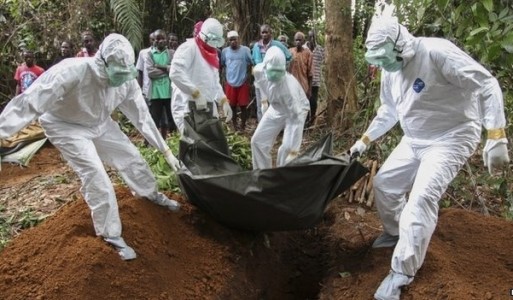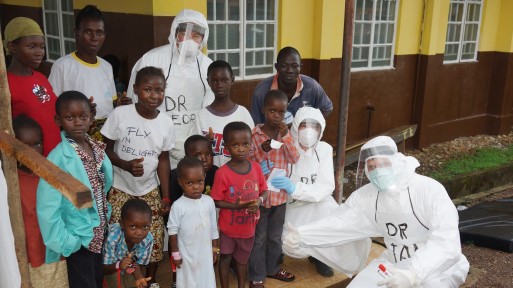When the Ebola epidemic ravaged West Africa in 2014 through 2015, much of the Western world was focused on one thing – containing the disease. But in the villages of Liberia, Guinea and Sierra Leone, where the virus claimed over 11,000 lives, volunteers from Médecins Sans Frontières (Doctors Without Borders) faced a far greater challenge – how to sensitively address the cultures and traditions of the region’s indigenous peoples regarding the care of the dead.
The science around the issue was dreadfully clear. Ebola is spread by direct contact with body fluids, and Ebola victims, who succumb to circulatory failure and catastrophic bleeding, are most contagious immediately after death. As the outbreak intensified during the summer of 2014, Red Cross, MSF and local volunteers developed elaborate decontamination and disposal procedures that included wrapping the dead in several layers of heavy-duty plastic shrouding before removing them and dousing the bodies – still wrapped in plastic — with bleach before burial. Family members were forbidden to have any physical contact with or, in some cases, even view their loved ones after they had died.
At the height of the outbreak, President Ellen Johnson Sirleaf of Liberia even declared a state of emergency in Monrovia when city residents became fearful about the hundreds of Ebola victims buried nearby. Stating, “Ebola has attacked our way of life,” she issued an order mandating the cremation of all Ebola victims, a practice unheard of in West Africa.
As sound as all this was from a scientific perspective, the steps taken by the government and MSF were an anathema to villagers whose loved ones had succumbed to the disease.
As sound as all this was from a scientific perspective, the steps taken by the government and MSF were an anathema to villagers whose loved ones had succumbed to the disease. After years of colonial oppression, many were already suspicious of Westerners and unwilling to accept scientists’ explanations of how the virus spread. Some doubted that Ebola existed at all.
In Sierra Leone, the Sherbro people sometimes examine the body of the dead to determine if the person was a witch; if so, the malevolent spirit must be cleansed from the body before burial.
Traditional burial practices and beliefs about how the spirits of the dead should be laid to rest compounded the problem. West Africa is populated mostly by Christians and Muslims, but burial practices are inextricably linked to tribal rituals and beliefs about the spirit world. Almost all West African families wash the dead by hand; Christians also close their eyes and dress them, while Muslims wrap the cleansed body in white cloth. In Sierra Leone, the Sherbro people sometimes examine the body of the dead to determine if the person was a witch; if so, the malevolent spirit must be cleansed from the body before burial. The Kissi people of Guinea believe a fetus must be removed from the body of a woman who dies while pregnant before she is buried. Other practices involve holding and kissing the dead.
Yet the scientists, medical volunteers and government were adamant that safe burial practices must be upheld, and unrest among the people of the West African nations grew. Stunned by grief and angered by the denial of their most sacred beliefs, many villagers began hiding Ebola victims in remote areas and burying them in shallow graves. In Sierra Leone’s hospitals, dedicated Ebola beds lay empty, as victims chose to stay home and die rather than seek treatment and risk cremation after death.
The reaction should have been anticipated, according to anthropologists Barry and Bonnie Hewlett, who studied the emerging epidemic in Uganda in 2000 and reported their findings in the book, Ebola, Culture and Politics: The Anthropology of an Emerging Disease. Keeping families from performing burial rites is viewed as both an insult to the dead and dangerous to his or her family. They explain, “In the event of an improper burial, the deceased person’s spirit (tibo) will cause harm and illness to the family.”
Building a bridge across this enormous cultural divide was not an easy task, but as the death toll rose, the volunteers on the front lines saw all too clearly that something had to be done.
Officials enlisted the help of tribal elders and priests, some of whom had lived through prior epidemics and understood that traditions sometimes needed to be abandoned in the service of public health.
Officials enlisted the help of tribal elders and priests, some of whom had lived through prior epidemics and understood that traditions sometimes needed to be abandoned in the service of public health. Muslim cleric Munnirou Abyusuf, for example, explained in an interview with National Geographic that when he saw health care workers and scientists dying from the disease, he realized just how dangerous it was. “I told people, this is not the first plague,” he said. “You do not need to wash the corpse. You can pray in absentia. The rules are not absolute.”
The World Health Organization also issued a statement urging officials in all of the affected regions to begin instituting procedures that allowed a “safe and dignified” burial of the Ebola dead. The statement outlined a number of processes to improve communication between bereaved families and volunteers, and included these comments from Elhadj As Sy, Secretary General, of the International Federation of the Red Cross and Red Crescent Society: “We are becoming known for ‘dead body management,’ but we do not ‘manage’ dead bodies. We safely, respectfully and in a dignified manner accompany our deceased fellow human beings and help to prepare them, in accordance with their cultures, for their last resting places….Providing safe alternatives for families to maintain deeply-cherished practices helps them be part of the decision-making process, which is critical particularly during a time when they may be feeling helpless.”
Tyvec-suited MSF volunteers agreed to dress Ebola victims, who had died, in their favorite outfits before burial, and family members were allowed to hold brief memorial services over their loved ones’ remains before the bodies were taken to a mass grave.
Officials also hired people like Andrew Kondoh, a Sierra Leone native who helped dispose of the dead during the country’s civil war, to act as liaisons between the medical burial teams and the villagers. And as the two sides began to communicate, walls and suspicions began to fall away. Tyvec-suited MSF volunteers agreed to dress Ebola victims, who had died, in their favorite outfits before burial, and family members were allowed to hold brief memorial services over their loved ones’ remains before the bodies were taken to a mass grave. Ceremonies were modified and families were allowed to view their loved ones after death.
The efforts paid off. Unsafe burial practices, believed to be the cause of nearly 60 percent of all Ebola cases in West Africa, became less frequent, and the number of new cases of Ebola began to decrease. By May 2015, the epidemic was largely contained, although new cases have continued to appear sporadically. The latest fatality, a 15 year-old Liberian boy whose father and brother are also being treated for the disease, occurred on Nov. 22, 2015, just three months after WHO declared the country Ebola-free.

 A Clash Between Science and Culture
A Clash Between Science and Culture




 “Help Me, Helen”
“Help Me, Helen”
 Recovering Cremation Remains After the Los Angeles Fires
Recovering Cremation Remains After the Los Angeles Fires
 “As Tears Go By” by Marianne Faithfull
“As Tears Go By” by Marianne Faithfull














